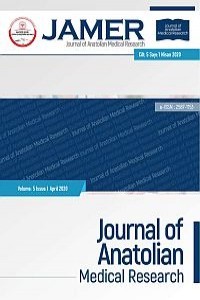MPS’de SPECT/BT ve EKG-Gated ile Atenüasyon Düzeltmeli̇ Görüntüleri̇n Eklenmesi̇ Hangi̇ Hasta Grubu İçi̇n Faydalıdır?
Atenüasyon düzeltme, Miyokard perfüzyon sintigrafisi, SPECT/BT
Adding Attenuation Corrected Images with SPECT/CT and ECG-Gated in MPI is Usefull for Which Group of Patient?
Attenuation correction, myocardial perfusion imaging, SPECT/CT,
___
- 1. Sharma, Patel CD, Karunanithi S, Maharjan S, Malhotra A. Comparative accuracy of CT attenuation-corrected and non-attenuation-corrected SPECT myocardial perfusion imaging. Clinical Nuclear Medicine. 2012; 37(4): 332-8.
- 2. Burrell S, MacDonald A. Artifacts and pitfalls in myocardial perfusion imaging. Journal Of Nuclear Medicine Technology. 2006;34(4): 193-211.
- 3. DePuey EG. How to detect and avoid myocardial perfusion SPECT artifacts. Journal of Nuclear Medicine. 1994; 35(4): 699-702.
- 4. Berman DS, Kang X, Nishina H, Slomka PJ, Shaw LJ, Hayes SW et al. Diagnostic accuracy of gated Tc-99m sestamibi stress myocardial perfusion SPECT with combined supine and prone acquisitions to detect coronary artery disease in obese and nonobese patients. Journal of Nuclear Cardiology. 2006; 13(2): 191-201.
- 5. Links JM, DePuey EG, Taillefer R, Becker LC. Attenuation correction and gating synergistically improve the diagnostic accuracy of myocardial perfusion SPECT . Journal of Nuclear Cardiology. 2002; 9(2): 183-7.
- 6. Gaemperli O, Kaufmann PA, Alkadhi H. Cardiac hybrid imaging. European Journal of Nuclear Medicine and Molecular İmaging. 2014; 41(1): 91-103.
- 7. Ansheles AA. Specific features of interpretation of myocardial perfusion single-photon emission computed tomography with computed tomographic absorption correction. Vestnik Rentgenologii i Radiologii. 2014; (2): 5-20.
- 8. Bonow RO. Gated myocardial perfusion imaging for measuring left ventricular function. J Am Coll Cardiol. 1997; 30(7): 1649-50.
- 9. Gimelli A, Rossi G, Landi P, Marzullo P, Iervasi G, L’abbate A et al. Stress/Rest Myocardial Perfusion Abnormalities by Gated SPECT: Still the Best Predictor of Cardiac Events in Stable Ischemic Heart Disease. Journal of Nuclear Medicine. 2009; 50(4): 546-53.
- 10. Hedén B, Persson E, Carlsson M, Pahlm O, Arheden H. Disappearance of myocardial perfusion defects on prone SPECT imaging: comparison with cardiac magnetic resonance imaging in patients without established coronary artery disease. BMC Medical Imaging. 2009; 9: 1-9.
- 11. Heiba SI, Hayat NJ, Salman HS, Higazy E, Sayed ME, Saleh Z et al. Technetium-99m-MIBI myocardial SPECT: supine versus right lateral imaging and comparison with coronary arteriography. Journal of Nuclear Medicine. 1997; 38(10): 1510-4.
- 12. Notghi A, Low CS. Myocardial perfusion scintigraphy: past, present and future. Br J Radiol. 2011 ;84 Spec No 3(Spec Iss 3):229-36.
- 13. DePuey EG, Rozanski A. Using gated technetium-99m-sestamibi SPECT to characterize fixed myocardial defects as infarct or artifact. Journal of Nuclear Medicine: official publication, Society of Nuclear Medicine. 1995; 36(6): 952-5.
- 14. Bateman TM, Cullom SJ. Attenuation correction single-photon emission computed tomography myocardial perfusion imaging. Semin Nucl Med. 2005;35(1):37-51.
- 15. Thompson RC, Heller GV, Johnson LL, Case JA, Cullom SJ, Garcia EV et al. Value of attenuation correction on ECG-gated SPECT myocardial perfusion imaging related to body mass index. Journal of Nuclear Cardiology. 2005; 12(2): 195-202.
- 16. Taillefer R, DePuey EG, Udelson JE, Beller GA, Latour Y, Reeves F. Comparative diagnostic accuracy of Tl-201 and Tc-99m sestamibi SPECT imaging (perfusion and ECG-gated SPECT) in detecting coronary artery disease in women. Journal of the American College of Cardiology. 1997; 29(1): 69-77.
- 17. Heller GV, Bateman TM, Johnson LL, Cullom SJ, Case JA, Galt JR, et al. Clinical value of attenuation correction in stress-only Tc-99m sestamibi SPECT imaging. J Nucl Cardiol. 2004; 11(3):273-81.
- 18. Huang R, Li F, Zhao Z, Liu B, Ou X, Tian R, Li L. Hybrid SPECT/ CT for attenuation correction of stress myocardial perfusion imaging. Clinical Nuclear Medicine. 2011; 36(5): 344-9.
- 19. Hesse B, Tägil K, Cuocolo A, Anagnostopoulos C, Bardiés M, Bax J et al. EANM/ESC procedural guidelines for myocardial perfusion imaging in nuclear cardiology . European journal of nuclear medicine and molecular imaging. 2005; 32: 855-97.
- 20. Rozanski A, Gransar H, Hayes SW, Min J, Friedman JD, Thomson LE et al.Temporal trends in the frequency of inducible myocardial ischemia during cardiac stress testing: 1991 to 2009. Journal of the American College of Cardiology. 2013; 61(10): 1054-65.
- 21. Bhavnani SP, Heller GV. Stress-only myocardial perfusion imaging. It is time for a change! Journal of Nuclear Cardiology. 2011; 18: 836-9.
- 22. Worsley DF1, Fung AY, Coupland DB, Rexworthy CG, Sexsmith GP, Lentle BC. Comparison of stress-only vs. stress/rest with technetium-99m methoxyisobutylisonitrile myocardial perfusion imaging. European Journal of Nuclear Medicine. 1992;19: 441-4.
- 23. Schroeder-Tanka JM, Tiel-van Buul MM, van der Wall EE, Roolker W, Lie KI, van Royen EA. Should imaging at stress always be followed by imaging at rest in Tc-99m MIBI SPECT? A proposal for a selective referral and imaging strategy. The International Journal of Cardiac Imaging. 1997; 13: 323-9.
- 24. Trägårdh E, Valind S, Edenbrandt L. Adding attenuation corrected images in myocardial perfusion imaging reduces the need for a rest study. BMC Medical Imaging. 2013; 13(1): 1-5.
- Yayın Aralığı: Yılda 3 Sayı
- Başlangıç: 2016
- Yayıncı: Kayseri EAH
Ganime ÇOBAN, Büşra COŞANAY TEKDEN, Beril GÜLER, Fatma Betül ÇAKIR, Özlem TOLUK, Zuhal GUCIN, Şahande ELAGÖZ
Sekundum Atriyal Septal Defektli Çocuklarda Galektin-3
Fatma ÖZKUL, Mustafa ARGUN, Süleyman SUNKAK, Derya KOÇER
Erişkin Bir Hastada Künt Travma Sonrası Pseudomonas Aeruginosa’ya Bağlı Kalkaneal Osteomiyelit
Mustafa CİHANGİROĞLU, Ayşin KILINÇ TOKER, İhami ÇELİK
Alparslan DEMİRAY, Sümeyra KOYUNCU, Ramazan OZAN, Merve CİVAN, İsmail KOÇYİĞİT
Ebru SALMANOĞLU, Murat ÜZEL, Ökkeş BİLAL, Ayşegül ERDOĞAN
Primer Hiperhidroziste Uniportal Sempatektomi Deneyimimiz
Oğuzhan TURAN, Mehmet Akif TEZCAN, İbrahim Ethem ÖZSOY, Bayram METİN, Mehmet Akif EKİCİ
Timpanoplasti ve Timpanomastoidektomi; 5 Yıllık Sonuçlarımız
Aykut KURU, Yunus KANTEKİN, Serap BULUT ÇÖBDEN, Altan KAYA
Spontan Pnömotoraks COVID-19 Bi̇rli̇kteliği
Mehmet Akif EKİCİ, Oğuzhan TURAN, Bayram METİN, İbrahim Ethem ÖZSOY, Mehmet Akif TEZCAN
İnme Rehabilitasyonunda Akut Batını Taklit Eden Rektus Kılıf Hematomu: Vaka Sunumu
